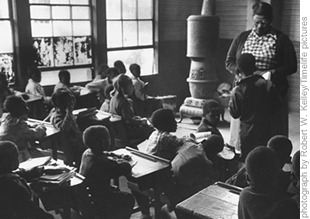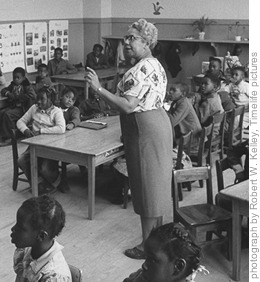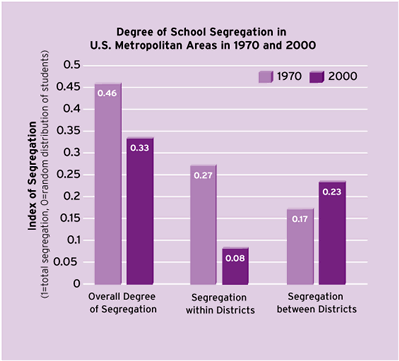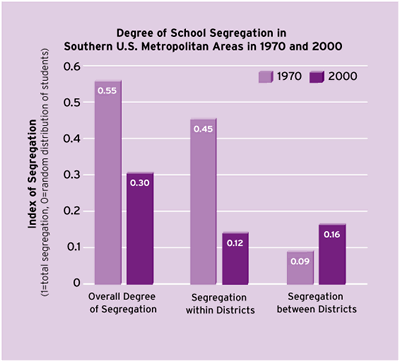 |
| Moving from segregated to integrated schools proved to be a mixed blessing.
|
In 1960 my world changed radically when, as a 2nd grader at P.S. 121 in East Harlem, I learned that I was among a group of students who would help fulfill the integration mandate of the Brown v. Board of Education decision. My principal and teacher announced that from then on my largely African-American and Latino classmates and I would be riding the bus to P.S. 183 in Yorkville, a predominantly white community on the Upper East Side of Manhattan.
My inaugural day at P.S. 183 included indignities like having my hair rubbed by one of my new classmates, a white girl who asked how I managed to comb it. I was also informed that while my academic performance had placed me in the highest track at my East Harlem school, I would be educated with the “average” kids at P.S. 183. My new teachers believed that it would be harder for me to keep up with the privileged students at my new school.
One-Way Integration
Though the goal of the busing program was to integrate P.S. 183, the students there remained predominantly white and from high-income families. Thus I had to adjust to a whole new set of realities. On a regular basis I was forced to battle my white teachers’ and classmates’ low expectations and negative perceptions about blacks and Latinos. Meanwhile, as one of the relatively few minority faces in the classroom, I was routinely called on to serve as the white person’s lens on the Negro experience.
Likewise, attending school in a well-to-do community aggravated my sense of my own poverty and forced me to engage in multiple, mostly futile attempts to mask it. Each September I dreaded writing about my summer “vacations” and cringed when we were asked if our parents might visit the class and talk about their careers and educational experiences.
To students like me, integration came to mean sending a small phalanx of mostly poor black and Latino children to attend schools in white neighborhoods. I never took the opportunity to learn what integration meant to my white classmates and teachers, but it certainly did not mean asking any of them to take my place at P.S. 121 in East Harlem. Moreover, none of us, including teachers and parents from the sending and receiving schools, was given much preparation. My parents literally prayed that they were doing the right thing. Some of my white teachers and classmates shared their prayers, while others barely hid their discomfort or disdain.
If life as a disadvantaged minority student in an essentially white school was complicated, coming home provided little respite. Time spent away from my East Harlem neighborhood was time lost in the complex negotiations required to maintain one’s social status — that is, being considered someone who could hold his own in sports, street games, adolescent verbal jockeying, and the occasional physical confrontation. Until my freshman year of high school, I attended “integrated” schools where I shouldered the dual burdens of learning a new culture while keeping up my “skills” in the neighborhood.
Don’t get me wrong; the experience had a tremendous up- side. Going to school outside of Harlem exposed me to the successful actors, authors, scientists, diplomats, and artists who were the parents of my white classmates; I was often invited to spend weekends at their homes. We were also taken on trips to nearby museums and universities. And I should mention that I was promoted to the highest track for 3rd grade and thereafter.
Nonetheless, by the time I reached Stuyvesant High School, I was tired of the effort and stress involved in maintaining dual citizenship. I soon reached a mutual agreement with my guidance counselor at Stuyvesant that I would be better off at Brandeis, a comprehensive neighborhood high school located on Manhattan’s Upper West Side. Despite its name, Brandeis served a predominantly poor and working-class black and Latino population (at that time schools were named without paying much attention to the culture and history of the surrounding community). I leapt at the chance to attend a school with my social and cultural peers. I must also admit an added incentive of leaving Stuyvesant was exchanging an all-boys school for the enhanced social opportunities at coeducational Brandeis.
On my first day at Brandeis, however, I was shocked to discover that I was being placed in the honors program. I was not amused by the irony that most of my fellow “honors” classmates were white. Within three months, I fixed this problem by performing poorly enough to be dropped from the honors program.
On my graduation in 1969, with a mix of average grades yet perplexingly high SAT scores, I fit the profile that progressive white colleges were looking for in their efforts to integrate higher education. Inspired by Malcolm X–and recognizing the colleges’ recruiting needs–I wrote an admissions essay entitled “Autobiography of a Ghetto Youth.” I decided to attend Macalester College in St. Paul, Minnesota, and my essay was later published in the brochure the college used for recruiting minority youth. And just as I was beginning to think about doctoral studies, graduate schools were seeking to integrate their programs. I enrolled at Cornell. My story is not unique; a number of my friends had the opportunity to attend schools like Oberlin, Antioch, Cornell, and Bowdoin. From these elite institutions they often went on to law or graduate school.
However, while integration opened wonderful new vistas for my friends and me, we represented a lucky few. Most children in my neighborhood continued to live lives untouched by the promise of Brown. Indeed, by removing some of the most talented students and involved parents from P.S. 121, the busing program contributed to the school’s severe decline in quality in the ensuing years–a pattern repeated in many urban schools with low-income, minority student populations. Many of the neighborhood children fell prey to the heroin epidemic and the crime and violence it spawned. Many of those who survived these neighborhood wars were drafted to fight in Vietnam. Others, like my two older brothers, graduated from neighborhood comprehensive or vocational high schools, returned from Vietnam, took blue-collar jobs, and began the social and economic trek from Harlem to homes in the suburbs.
 |
| The belief that black students could not learn in the absence of whites ignored the countless numbers of segregated schools that had produced the black professionals, farmers, and craftpersons who built vibrant communities despite being fettered by Jim Crow.
|
Progress and Setbacks
There is no denying what legal scholar Charles Ogletree describes as the symbolic importance of Brown. The decision signaled the beginning of the end of federal strictures supporting injustice. In addition, the concerted efforts to desegregate schools in the wake of Brown, combined with the creation of federal compensatory education programs aimed at low-income households, coincided with a narrowing of the achievement gap between whites and blacks during the 1960s and 1970s.
Yet Brown‘s power was attenuated by subsequent court decisions, policy choices, and social trends. For one thing, in the wake of the Brown decision, it took almost a year for the Warren Court to announce its remedy. Even then, the court ordered that schools be desegregated “with all deliberate speed.” In practice, schools would deliberate without much speed. As Ogletree and Derrick Bell have observed, this remedy lacked the boldness of the original decision and left states and local communities to interpret what constituted adequate progress toward desegregation. This was meant to ease whites’ resistance to integration by allowing states and localities to implement change over time. Perhaps this was prudent, but it enabled many communities, especially in the South, to exercise their prejudices by dragging their heels and resisting implementation of the law. After a decade of delay the federal government was forced to intervene in cities like Little Rock, Birmingham, and Boston, opening school doors with the barrel of a gun.
Moreover, when integration did occur, it usually traveled down a one-way street; white students were rarely asked to ride the bus to majority-black schools. This strategy placed the burden on the victims of discrimination, black children and their communities. Those black students who transferred to majority-white schools encountered a deeply hostile atmosphere where a range of practices kept them segregated, only now within the school’s walls. White school personnel used policies such as curriculum tracking and special-education referrals as a means of sorting students by race under the guise of “ability grouping” or meeting students’ “special needs.” Now the barriers to integration, once visible in the maintenance of separate schools, became hidden behind the classroom door.
This highlighted a major weakness in the Brown decision: the assumption that African-Americans, if they attended integrated schools, would have access to the same high-quality education as their white counterparts. W. E. B. Du Bois presaged the fallacies underpinning this thinking when he observed in 1935:
A mixed school with poor and unsympathetic teachers, with hostile public opinion, and not teaching of truth concerning black folk, is bad. A segregated school with ignorant placeholders, inadequate equipment, poor salaries, and wretched housing is equally bad. Other things being equal, the mixed school is the broader, more natural basis for the education of all youth. It gives wider contacts; it inspires greater self-confidence; and suppresses the inferiority complex. But other things seldom are equal, and in that case, Sympathy, Knowledge, and the Truth outweigh all that the mixed school can offer.
The Warren Court’s belief that black students could not learn in the absence of whites ignored the countless numbers of segregated African-American schools that had produced the black business people, lawyers, doctors, writers, artists, farmers, and craftpersons who built vibrant communities despite being fettered by Jim Crow. By equating integration with equality of education, the Brown decision left all-black schools tainted with suspicions of inferiority while giving all-white schools an undeserved presumption of excellence.
Flawed as the reasoning and implementation of Brown were, the decision is not to blame for the demise of the integrationist ideal. New economic opportunities and the urban riots of the 1960s conspired to propel white families’ flight to segregated cul-de-sacs in the suburbs (see Figure 1). The growing black middle class soon joined the exodus, leaving urban schools with the difficult task of educating the majority of the nation’s poor and minority students. Moreover, the Supreme Court, in its 1974 Milliken v. Bradley decision, ruled that the suburban districts around Detroit did not need to desegregate, on the grounds that they had never practiced explicit state-sponsored segregation. This decision constructed a fence around urban districts, making desegregation a hopeless dream rather than a realizable goal. Majority-minority school districts like Detroit’s have little recourse beyond pursuing voluntary and fairly limited interdistrict busing (usually one-way) or, in a few instances (Chattanooga-Hamilton County and Charlotte-Mecklenburg are examples), consolidating urban and suburban districts.
| Where Are We Now? (Figure 1) Segregation declined throughout the United States, especially in the South, between 1970 and 2000. However, the decline in segregation within school districts was partially offset by a growing degree of racial separation between school districts. |
 |
 |
| NOTE: The index of segregation can vary between 0 and 1; a score of 0 means that students are randomly distributed among schools, while a score of 1 indicates that students are completely segregated. The index is a measure of segregation of nonwhites from whites. SOURCE: Charles T. Clotfelter, After Brown: The Rise and Retreat of School Desegregation (2004) |
Today segregation remains a fact of life in our nation’s schools. According to the Harvard Civil Rights Project, it is also on the rise. Equally if not more disturbing is the fact that the black-white achievement gap began to widen again during the 1990s. The situation is particularly troublesome in urban schools, where performance on the National Assessment of Educational Progress of the average black or Latino 17-year-old matches that of the average white 13-year-old. More than half of all black and Latino students in urban schools will fail to graduate from high school; many leave as early as 9th grade.
The achievement gap continues to survive even in some of our nation’s most privileged communities, much to the dismay of the black and Latino parents who moved to the suburbs to acquire immunity from the ills of high-poverty urban schools. Studies show a familiar pattern: middle-income black and Latino students faring worse than their white counterparts with respect to grades, enrollment in advanced courses, and performance on standardized tests. These findings confirm the fallacy of equating integration with quality.
If the 50 years since Brown have taught us anything, it is that inequality has multiple roots that are deeply embedded in the soil of America’s educational, social, governmental, cultural, and spiritual life. Uprooting the problem will require a multipronged approach that addresses inequalities across the board and focuses on improving not just schools but entire communities. We must not abandon integration as a goal, but it is utopian to believe that schools alone can close an achievement gap that is the result of deeper economic and social inequities.
Warren Simmons is the executive director of the Annenberg Institute for School Reform at Brown University.


